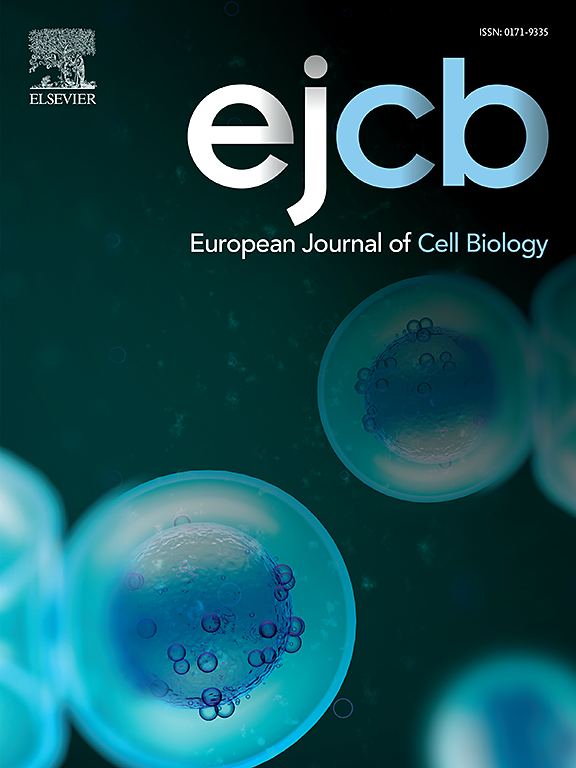LRP1参与非小细胞肺癌中fhit调节的HER2信号传导。
IF 4.3
3区 生物学
Q2 CELL BIOLOGY
引用次数: 0
摘要
肿瘤抑制因子脆性组氨酸三联体(FHIT)在非小细胞肺癌(NSCLC)中经常丢失。我们之前的研究表明,FHIT的下调会导致与上皮-间质转化(EMT)相关的HER2活性的上调,并且具有FHITlow/ pher2高表型的肺肿瘤细胞对抗HER2药物敏感。在这里,我们试图破译非小细胞肺癌中fhit调节的HER2信号通路。对从NSCLC分离的肿瘤细胞的转录组学分析显示,内吞受体低密度脂蛋白受体相关蛋白1 (LRP1)是膜运输和细胞信号传导的中心调节因子,可能是这种信号传导的潜在参与者。在80例非小细胞肺癌的免疫组化队列中,我们发现肿瘤细胞中低FHIT表达与高pHER2和LRP1表达之间存在显著关联。FHIT沉默实验表明,FHIT在肺细胞系中从mRNA和蛋白水平调控LRP1的表达。通过分析LRP1和HER2之间的关系,我们发现抗HER2靶向治疗逆转了FHIT沉默诱导的LRP1过表达,而LRP1沉默不影响HER2活性。通过研究LRP1的功能作用,我们发现FHIT沉默诱导的细胞增殖和侵袭是依赖于LRP1的。此外,我们发现LRP1沉默可以抵消FHIT失活对vimentin的诱导。这些结果表明,LRP1作用于HER2的下游,在FHIT丢失后诱导EMT和肿瘤进展。在fhit阴性NSCLC中,HER2和LRP1的双重靶向可能是一种更有效地抑制HER2信号传导的治疗策略。本文章由计算机程序翻译,如有差异,请以英文原文为准。
LRP1 involvement in FHIT-regulated HER2 signaling in non-small cell lung cancer
The tumor suppressor fragile histidine triad (FHIT) is frequently lost in non-small cell lung cancer (NSCLC). We previously showed that a down-regulation of FHIT causes an up-regulation of the activity of HER2 associated to an epithelial-mesenchymal transition (EMT) and that lung tumor cells harboring a FHITlow/pHER2high phenotype are sensitive to anti-HER2 drugs. Here, we sought to decipher the FHIT-regulated HER2 signaling pathway in NSCLC. Transcriptomic analysis of tumor cells isolated from NSCLC revealed the endocytic receptor low density lipoprotein receptor-related protein 1 (LRP1), a central regulator of membrane trafficking and cell signaling, as a potential player of this signaling. In a cohort of 80 NSCLC assessed by immunohistochemistry, we found a significant association between a low FHIT expression and a high pHER2 and LRP1 expression by tumor cells. Experiments of FHIT silencing showed that FHIT regulated LRP1 expression both at the mRNA and protein levels in lung cell lines. Analyzing the relationship between LRP1 and HER2, we observed that an anti-HER2 targeted therapy reversed LRP1 overexpression induced by FHIT silencing whereas LRP1 silencing did not affect HER2 activity. Studying the functional role of LRP1, we showed that cell proliferation and invasion induced by FHIT silencing were LRP1-dependent. In addition, we found that the induction of vimentin upon FHIT inactivation was counteracted by LRP1 silencing. These results suggest that LRP1 acts downstream of HER2 to induce EMT and tumor progression following FHIT loss. Dual targeting of HER2 and LRP1 might represent a therapeutic strategy to more efficiently inhibit HER2 signaling in FHIT-negative NSCLC.
求助全文
通过发布文献求助,成功后即可免费获取论文全文。
去求助
来源期刊

European journal of cell biology
生物-细胞生物学
CiteScore
7.30
自引率
1.50%
发文量
80
审稿时长
38 days
期刊介绍:
The European Journal of Cell Biology, a journal of experimental cell investigation, publishes reviews, original articles and short communications on the structure, function and macromolecular organization of cells and cell components. Contributions focusing on cellular dynamics, motility and differentiation, particularly if related to cellular biochemistry, molecular biology, immunology, neurobiology, and developmental biology are encouraged. Manuscripts describing significant technical advances are also welcome. In addition, papers dealing with biomedical issues of general interest to cell biologists will be published. Contributions addressing cell biological problems in prokaryotes and plants are also welcome.
 求助内容:
求助内容: 应助结果提醒方式:
应助结果提醒方式:


